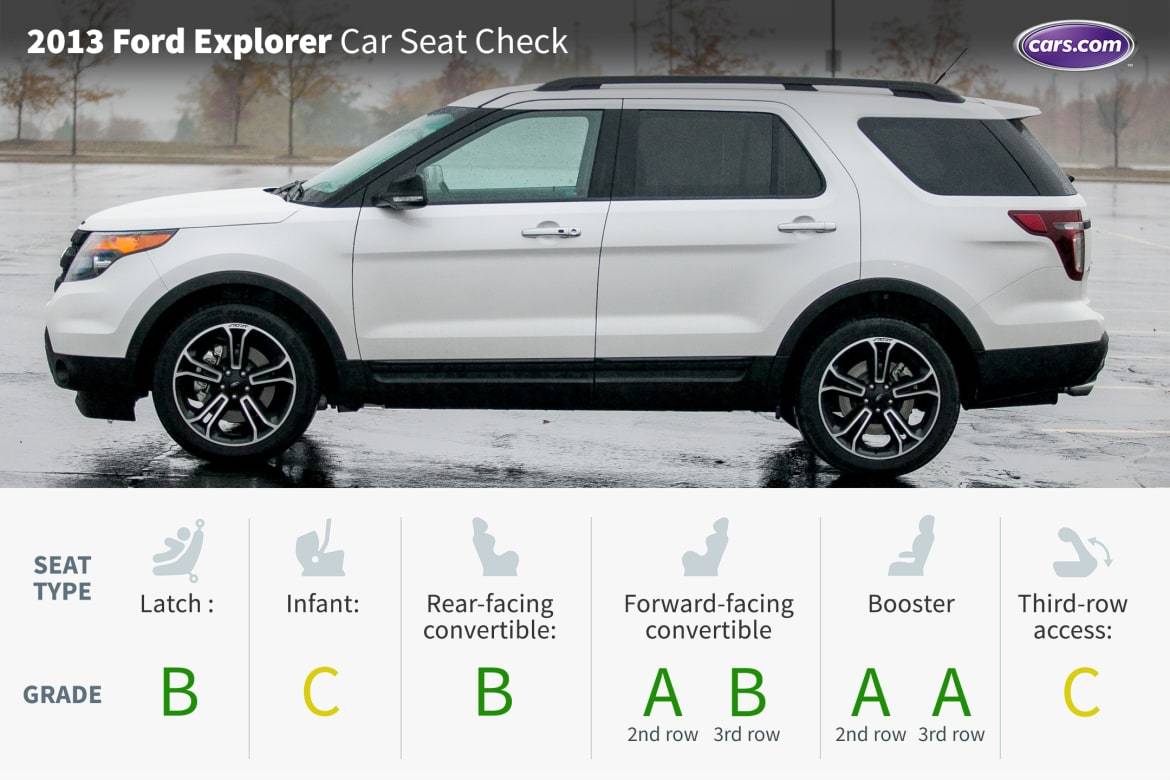2013 Ford Explorer: Car Seat Check


With its standard three rows of seats, the Ford Explorer is a crossover that begs for family duty. For 2013, Ford added a new top-of-the-line Sport trim to its Explorer lineup. The Explorer Sport that we tested had seating for seven, though second-row captain’s chairs, which reduce seating capacity to six, are available.
The Explorer also has optional inflatable seat belts for the second row’s outboard seats. These seat belts are safe to use with child-safety seats, according to the Explorer’s owner’s manual, and just this week, car-seat manufacturer Britax announced that it independently approved the inflatable seat belt for use with its car seats. These seat belts are part of a $595 safety package that includes a blind spot monitoring system.
For the Car Seat Check, we use a Graco SnugRide 30 rear-facing infant-safety seat, a Britax Roundabout convertible child-safety seat and Graco high-back TurboBooster seat.
The front seats are adjusted to a comfortable position for a 6-foot driver and a 5-foot-8 passenger. The three child seats are installed in the second row. The booster seat sits behind the driver’s seat, and the infant seat and convertible seats are installed behind the passenger seat. We also install the convertible seat in the second row’s middle seat with the booster and infant seat in the outboard seats to see if three car seats will fit. If there’s a third row, we install the booster seat and a forward-facing convertible.
Here’s how the 2013 Explorer did in Cars.com’s Car Seat Check:








Latch system: The Explorer has three sets of lower Latch anchors. In the second row, the anchors are in the outboard seats. While they’re visible in the seat bight, using them was somewhat difficult because the firm seat cushions block access to them.
The third row has one set of Latch anchors in the passenger-side seat. These anchors stick out from between the seat cushions, making them much easier to use than their second-row counterparts.
There are three tether anchors in the second row and a fourth anchor in the third row. All the tethers are at the base of the seatbacks. In our test car, the seats’ thick upholstery partially covered the anchors. We had to push it down to use the tethers, which was an annoyance.
Booster seat: The Explorer’s inflatable seat belt worked well with our high-back booster seat, which fit easily in the second-row seat. The inflatable seat belt buckle is larger than a traditional buckle, but it shouldn’t present any problems to kids buckling up independently.
The booster also fit easily in the third row (photo above). There’s just enough seat bolstering to keep it in place, and the traditional seat belt buckles are on a stable base and easy to use.
Convertible seat: The forward-facing convertible fit well in the 60/40-split second row. The seat directly behind the front passenger could move forward and back and the seatback could recline somewhat, making installation easier. The second row’s other seats were fixed in place. When we flipped the car seat around to install it in the rear-facing position, we had to move the front passenger seat forward to accommodate the car seat; the front passenger had enough legroom to sit comfortably. We had some troubles connecting to the Latch anchors, too.
In the third row, the forward-facing convertible was easily connected to the Latch anchors. However, the third row’s sizable fixed head restraints pushed our car seat forward a little.
Infant-safety seat: We also had to move the front passenger seat forward to install this rear-facing car seat. The front passenger still had adequate legroom, though. Installing this car seat took some time and effort because we had to muscle the car seat’s hook-like connectors past the cushions to get at the car seat.
Third-row access: The second-row seats tumble forward to access the third row, but parents won’t be able to tumble the seats forward when car seats are installed in the second row. Also, the seats are very heavy. Parents should also check out the Explorer’s step-in height, which was quite high. With the rear door open, the Explorer’s floor hit our 5-foot-8-inch tester at her knees.
How many car seats fit in the second row? Two
How many car seats fit in third row? Two
Editor’s note: For three car seats — infant-safety seat, convertible and booster seats — to fit in a car, our criterion is that a child sitting in the booster seat must be able to reach the seat belt buckle. Parents should also remember that they can use the Latch system or a seat belt to install a car seat.

Editor-in-Chief Jennifer Newman is a journalist with more than 25 years of experience, including 15 years as an automotive journalist at Cars.com. Jennifer leads the Editorial team in its mission of helping car shoppers find the vehicle that best fits their life. A mom of two, she’s graduated from kids in car seats to teens behind the steering wheel. She’s also a certified car-seat technician with more than 12 years of experience, as well as member of the World Car Jury, Automotive Press Association and Midwest Automotive Media Association. LinkedIn: https://www.linkedin.com/in/jennilnewman/ Instagram: @jennilnewman
Featured stories








